115 Years, 115 Impactful Moments
Click to play USC Viterbi's 115th anniversary trivia game
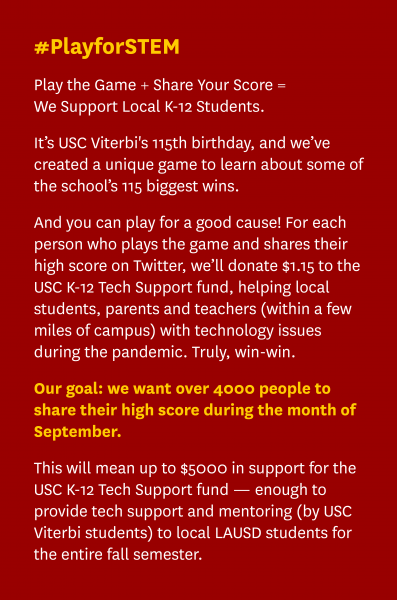 In 1905, USC offered its very first engineering courses out of the physics and mathematics departments.
In 1905, USC offered its very first engineering courses out of the physics and mathematics departments.
One hundred and fifteen years later, the USC Viterbi School of Engineering has a name and a host of accomplishments over the ensuing 11.5 decades.
This past May, Dean Yannis Yortsos, working with USC Viterbi vice deans, chairs, and select senior faculty, sought to identify 115 amazing USC Viterbi accomplishments by faculty, students and alumni over that span of time. This list would span all eight departments, the famed USC Information Sciences Institute and various programs of the school.
This list, like many of its kind, suffers from a clear recency bias. It is by no means the definitive list of all the USC Viterbi School’s noteworthy accomplishments! However, despite these limitations, perhaps it will serve as a helpful primer on what George Bekey, USC Viterbi professor emeritus, once called the school’s “remarkable trajectory.”
Test your knowledge of these USC Viterbi “wins” in a “Who Wants To be A Millionaire”-style interactive game above.
Or, for those who prefer to dive right in…the full list of 115 accomplishments for 115 years awaits.
Research/Global Challenges
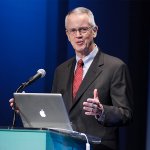
In 2010, USC Viterbi hosts the second ever NAE Grand Challenges Summit.
The event, to promote society’s most pressing challenges, has nearly 1000 attendees and over 50 engineering deans.
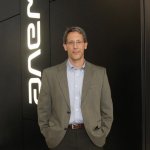
The USC-Lockheed Martin Quantum Computing Center (QCC), led by USC professor Daniel Lidar and ISI’s Robert F. Lucas, launches in 2012. Utilizing the world’s first commercial adiabatic quantum processor, the D-Wave One, USC remains the only university in the world to be hosting and operating a commercial quantum system.
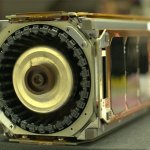
The first commercial space vehicle is launched by Space Exploration Technologies (SpaceX) in 2010, carrying a communications nano-satellite developed in part by ISI and its Space Engineering Research Center (SERC).
Similarly, in 2012, a nano-satellite designed and built at ISI and USC is launched successfully.
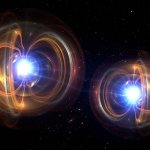
Quantum researcher Federico Spedalieri of ISI witnesses the “entanglement effect” in 2014, demonstrating that the D-Wave system is actually performing quantum processing.
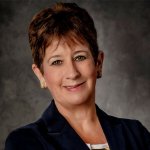
ISI partners with UC Berkeley on Cyber Defense Technology Experimental Research (DETER) in 2004, a major cybersecurity testbed.
Led by ISI’s Terry Benzel, DETER has spun off three innovative new testbeds, three international partner testbeds, and won a DHS Award in 2017.
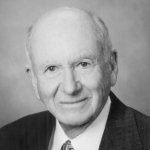
In 1971, Keith Uncapher, who heads RAND Corporation's computing group, approaches USC about creating a computer science institute, and the Information Sciences Institute (ISI) is launched five days later.
ISI, known as USC’s “crown jewel” research institute, has been led by prolific scientists such as Herbert Schorr and Prem Natarajan, who led the expansion of ISI to Arlington, VA, and Waltham, MA, respectively, and Craig Knoblock, the current ISI Michael Keston Executive Director.
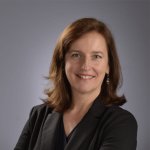
Pegasus software, whose development is led by ISI's Ewa Deelman, is instrumental in detecting gravitational waves in 2016, contributing to a Nobel Prize.
The long-awaited discovery, predicted by Einstein’s Theory of Relativity and made by Laser Interferometer Gravitational-Wave Observatory physicists, is among hundreds of projects and millions of workflows managed with Pegasus.
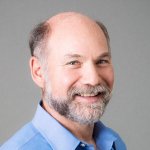
In 1997, ISI's Carl Kesselman, in partnership with Argonne National Laboratory and University of Chicago colleagues, creates grid computing, the prototype for the now-standard Globus open-source software.
Grid computing becomes fundamental to genetics and other data-intensive research, and has so far contributed to a Nobel Peace Prize and two Nobel Prizes in Physics.

In 1999 and 2003, the Daniel J. Epstein Department of Industrial and Systems Engineering establishes two nationally-funded interdisciplinary research centers, the National Center for Metropolitan Transportation Research (METRANS), and the Center for Risk and Economic analysis of Terrorism Events (CREATE).
CREATE becomes the Department of Homeland Security’s first University Center of Excellence.
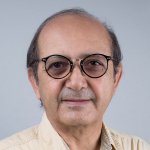
In 2006, The History Channel selects Berok Khoshnevis' Contour Crafting method of robotic 3-D printed construction as one of its top 25 inventions for the network's Modern Marvels program.
The technology was selected from over 4000 candidates by The History Channel and the National Inventors Hall of Fame.
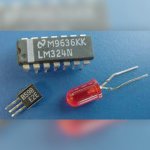
A successful USC proposal to the Joint Services Electronics Program in 1962 helped transform USC into a major research university.
The catch was (then chair, future dean and provost) Zohrab Kaprielian did not have sufficient faculty to do the work. He took the possibility of this award to President Norman Topping and obtained authorization for 10 new faculty positions. USC’s selection was the catalyst for the two decades of dramatic growth and development that were to follow, not only in electrical engineering, but all aspects of the solid-state sciences on the campus.
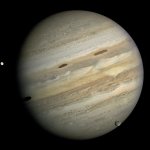
In 1979, Voyager I arrives at Jupiter and begins sending back striking images thanks to basic coding by Andrew Viterbi and error coding by Irving Reed and Gus Solomon.

In 1955, Sol Golomb publishes a classic paper on shift register sequences, key to creating digital signals that can be easily detected in noisy environments.
The basis of this research was cited in Prof. Golomb’s U.S. National Medal of Science.
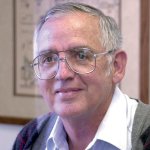
In 1996, Professor Bob Scholtz founded the Ultrawideband Radio Laboratory (UltRa Lab), a highly influential lab, which, for nearly a quarter century, has promoted the study of ultra-wideband radio technology.
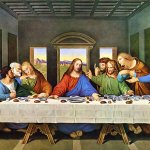
In 2009, Professor Costas Sioutas and his team played an integral role in in saving Leonardo Da Vinci’s masterpiece, “The Last Supper,” from Milan’s air pollution by developing state-of-the-art aerosol technologies to assess the toxicity of particulate matter air pollution.
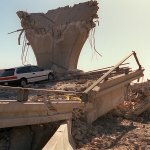
After the devastating Northridge earthquake in 1994, USC civil engineers, including Professor Victor Weingarten, developed new finite element techniques to simulate steel-and-concrete, beam-column structural connections and their potential failure, a real benefit to developers.
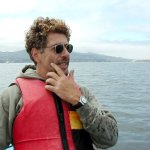
In 1998, Costas Synolakis, founder of the USC Tsunami Research Center (TRC), and his team developed cutting-edge tsunami modeling software used by leading government agencies like the National Oceanic and Atmospheric Administration, or NOAA for real time operational warnings. Most tsunami hazard maps in the western US were produced by the same technology.
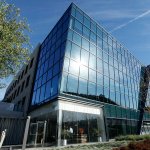
In 1999, the USC Institute for Creative Technologies was established with funding from the US Army to develop award-winning advanced immersive experiences.
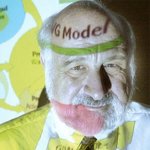
During the ’90s, Michael Arbib led the development of Neural Simulation Language (NSL) to model behavior and thought, including realistic modeling of macroscopic brain structures.
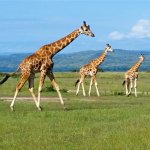
Milind Tambe pioneers “AI for Good,” using AI to protect U.S. ports, airports and infrastructure from terrorists. The technology was also used as part of the largest global deployment of predictive AI to thwart poachers and protect endangered animals.
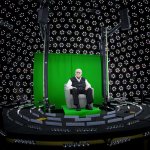
Now debuting at the Smithsonian, the New Dimensions in Testimony at ICT, in partnership with USC Shoah, is the world’s first ever re-creation of interactive, 3D avatars of Holocaust survivors for future generations.
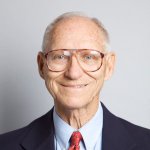
In 1981, Barry Boehm created the now-standard “constructive cost model,” a model for estimating effort, cost and schedule of software projects.
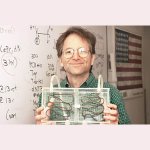
In 1994, Leonard Adleman, who coined the term “computer virus,” invented DNA computing, which involves performing computations using biological molecules rather than traditional silicon chips.
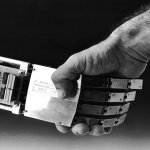
Equipped with the ability to adapt to arbitrary shapes without any external control, pioneering roboticist George Bekey co-created the world’s first five-fingered robot in 1977—the first able to give a true handshake.

The USC Biomedical Simulations Resource (BMSR), USC Viterbi’s longest continuously funded NIH-research center, has since 1985 produced software like ADAPT, used in the development of Herceptin – the first biologic developed for the treatment of breast cancer, as well as Rituxan for treating non-Hodgkin’s lymphoma.
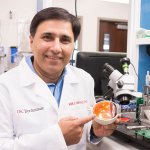
After 25 years of research, Mark Humayun’s Argus 2 device became in 2013 the first FDA approved artificial retina in the United States to restore sight to the blind.
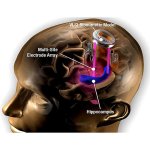
In 2011, Professor Ted Berger’s brain implant became the first medical device in the world to restore lost memory function and strengthen recall. The MIT Technology Review later named it as one of the “10 Breakthrough Technologies of 2013.”
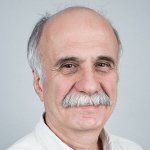
Professor Mike Gruntman was a member of the IBEX spacecraft team that in 2008, for the very first time, mapped the interstellar frontier of the solar system.
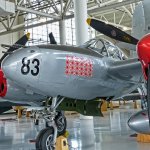
USC Engineering secured its first major research contract in 1944 in the amount of $10,000 from Lockheed Aircraft for studies of spot-welding aluminum alloy.
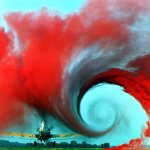
In 1974, Fred Browand published the classic paper that builds on work by Richard Kaplan and Ron Blackwelder on how to reduce air drag on vehicles, research that continues to influence vehicle design to this day.
Cited 1400 times, it was the first to show experimentally that two or more vortices in fluid flows have tendency to merge to form larger vortices. This concept continues to be utilized today to control the growth of the shear layers, reduce noise from jets and control the mixing within shear layers.
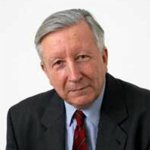
Terence Langdon, who served as a professor in three USC departments, elongated metals by a record 7000% in the 1980s.
His research focused on creep, superplasticity and UFG materials and he published over 1,000 peer-reviewed papers.
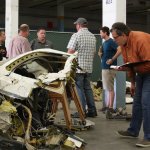
USC Viterbi's Aircraft Investigation Lab is among the best in the world.
For over 60 years, USC professors have taught pilots, aircraft investigators, and aviation officials about why planes crash and how to prevent these failures through the USC Aviation Safety and Security Program. This program operates around the globe, teaching how to identify hazards in aircraft systems and take action to prevent them from manifesting into an accident.
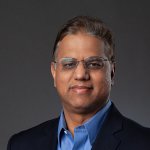
The Center for Advanced Manufacturing launched on February 24, 2017.
The 6,000-square-foot center just off the University Park campus houses the latest technologies and fosters innovative research aimed at advancing additive manufacturing, digital manufacturing, automation and smart manufacturing. A recent project aimed at COVID-19 is a disinfection robot named ADAMMS.

In 1988, Patrick Huerre and Larry Redekopp, professors in the Department of Aerospace and Mechanical Engineering, published a seminal work in “Phys. Rev. Letters” defining the fundamental mechanism for onset of global instability and frequency selection criteria in hydrodynamic flows.
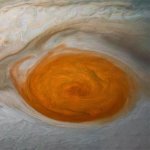
In 1976, USC Viterbi professors Tony Maxworthy and Larry Redekopp published a paper in Nature explaining Jupiter’s Great Red Spot as a solitary wave in the Jovian Atmosphere.
Maxworthy and Redekopp were long-time collaborators in the Department of Aerospace and Mechanical Engineering, largely focusing on fluid mechanics, from the microscale processes in jets to the macroscale of oceans and atmospheres in space.



